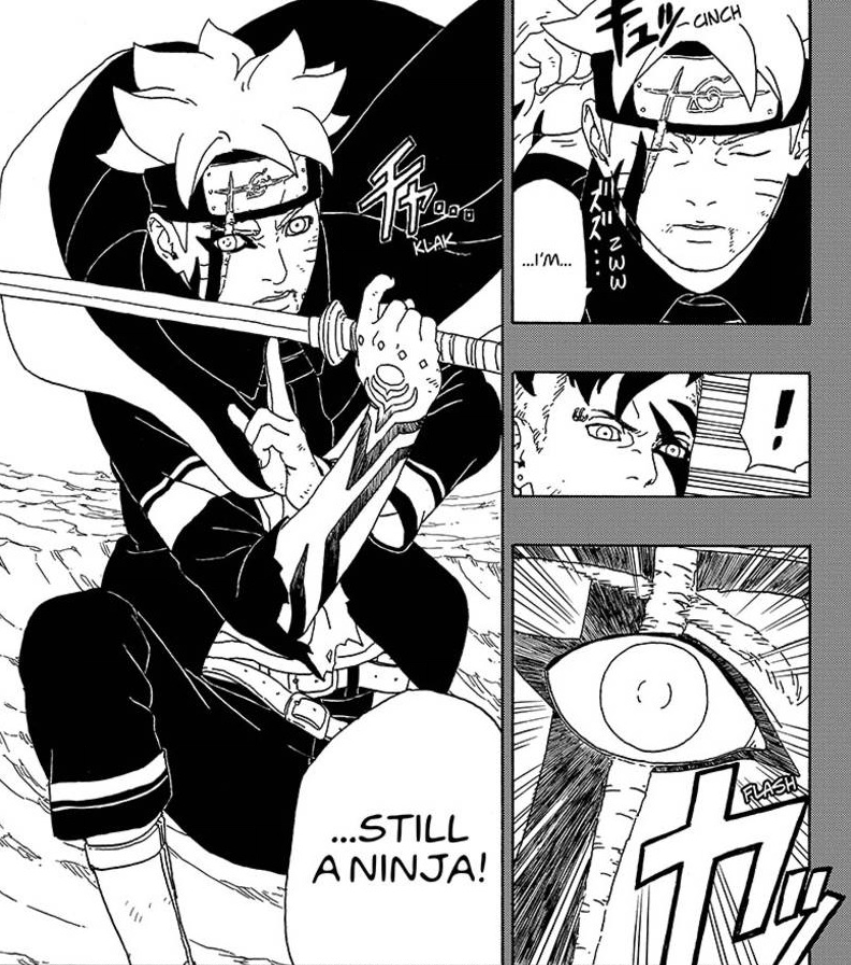The Same New Fate of Shinobi
warlic on the theme of fate in Naruto and Boruto

Happy Monday, all. Today, I'm turning the reins of the blog over to warlic (@warlic.bsky.social) with this reflection on the subject of fate in both Naruto and Boruto.
Enjoy!
From the first chapter of Boruto: Naruto Next Generations (NNG) to the climax of the first arc, it is clear that despite the passage of time, "The more things change, the more things stay the same." One of the often underappreciated ways this manifests is how the Naruto and Boruto series complement each other in relation to an under-explored theme: fate.
Early in Naruto, it is established that certain shinobi are often stuck with a fate saddled upon them, wherein some are set to never succeed.
When Lee was crushed by Gaara after giving it his all and failing, Neji, a shinobi who both benefited and was cursed by fate, posited that the heavens themselves would not allow Lee to advance; it was his fate for a shinobi like him, unable to use ninjutsu, to never win.
When facing Naruto, the dunce of his class, Neji noted that with his eyes he could determine that Naruto’s dreams were destined to never come to pass. His abilities, supposedly set at birth, precluded him from it; it was his fate instead to simply lose to him.
However, despite the presence of this fate, it is not set in stone. In Naruto, one can overcome their fate with sufficient effort, manifesting in Naruto’s defeat of the genius of the Hyūga, and later on, overcoming the fated Curse of Hate between himself and Sasuke. Similarly, Neji himself chooses to sacrifice himself on his own terms, denying fate’s sway over him, as Naruto had told him all those years ago.
The Boruto series retains this notion of fate, fitting with the evolution of the era. The plot takes on a more scientific approach, as outlined most clearly by Isshiki in chapter 47, literally titled Predestined Fate. Isshiki posits that everyone is born with a predestined fate, written into their genetics, indicating a similar view to Neji’s predestination, even to the point of clones sharing their template’s fate. It is fitting that the child of Naruto named after Neji (with Neji meaning screw, and Boruto meaning bolt) would embody these aspects.
While Boruto continues Naruto’s idea of fate by birth, in its approach, it actually flips it on its head. While fate in Naruto was most often what could not be accomplished, seen most clearly with underdogs like Lee and Naruto being fated to inferiority, in Boruto, many of the fates are, not what they cannot do, but rather what they will do, essentially being forced into a certain role. While this is more literal in the case of the Kāma, a literal branding that ties the victim into the fate of the Ōtsutsuki (which also drives some of them into a self-destructive cycle, as seen with Kawaki whose fate becomes forevermore intertwined with the clan from Isshiki’s Kāma, acting as his own personal curse), it was seen elsewhere that one can have a “positive” forced fate. Mitsuki and others opine that Boruto, being the son and grandson of two Hokage, is essentially fated to carry on their legacy through his pedigree and also become one, inheriting the role of his family.Yet, Boruto refuses this notion, stating he will walk his own path, overcoming fate, inadvertently repeating the same choice his father made nearly two decades ago.
Similarly, Kashin Koji was fated to die as his genetic source was, but ultimately, through a twist of fate, he overcame that destiny, ironically by unlocking an ability that lets him see fate, allowing him to thereby change it. Thus, he is able to escape certain death against his foe, unlike Jiraiya.
The Boruto anime strongly complements this theme. Early on a recurring point is that Boruto dislikes being compared to his father, as if his own efforts are negligible due to his heritage. This contrasts an anime-original character, Karatachi Kagura, who is similarly descending from a Kage. Yet in his case, the comparison between him and the Kage is less positive. Yagura was seen as a monster that further soaked the Bloody Mist Village, and that stigma carries unto his progeny. While Boruto is heralded as someone who will succeed no matter what because of his genetics, Kagura is someone who is fated to be a killer no matter what, because of his genetic fate. Boruto, of course, takes issue with this, illustrating a clear motif for his character, that anyone should be free to walk their own path no matter what destiny has been placed at their feet. Indeed, at the end of the arc, Kagura manages to overcome the machinations of the villain Shizuma, who wished to return the village to horrors of the past by exploiting Kagura’s fate through his connection to Yagura, showing Kagura’s life is his own to lead, no matter to whom he was borne from.
The novelization of this arc adds a similar yet distinct analysis of this motif between Buntun and Sarada. Buntun is a kunoichi that has suffered greatly due to the machinations of Uchiha clan before Sarada’s birth, and she lays some of the blame at their successor. This shows that fate is tied not only into one’s path, but also the consequences surrounding them. In the end, Buntun tries to force Sarada to be a killer like she expects the Uchiha to be, but taking after her friend, Boruto, Sarada refuses to succumb to fate and manages to defeat the Kiri-nin without any fatality. Many other examples abound in the anime in which characters manage to escape the role set for them by their genetics, by fate.
A strong example of the more scientific and genetic side of the way Boruto handles fate is seen in an anime-original arc featuring a returning character, Jūgo. In the original manga, Jūgo was shown to be a sort of Jekyll and Hyde type, a character trapped between a peaceful personality and a manic freak, earning him the name of “Jūgo of Two Scales.” It is later revealed and explained this condition arises due to a mutation in his clan, essentially a genetic “gift” that grants them great power in exchange for the instability. It is ironic that Jūgo’s ability, which is actually the origin of the curse mark, has such an effect, wherein the Kāma branding is itself also compared to a curse mark, as both set the victim’s fate.
In his eponymous arc in the Boruto anime, Jūgo is compared to a species of bird that has forgotten the ability to fly through its evolution or a beast of prey. Much like how a bird either has the instinct to fly or they do not, or that a predator will consume prey without a choice, Tosaka, someone who is an expert on both birds and Jūgo’s condition, claims that Jūgo cannot overcome his nature, that he is fated to be a monster by his genetics and schemes to use this fate to his own ends. However, his plans are foiled as Jūgo overcomes his instincts, and a bird that Tosaka said was fated to never fly takes aloft, with Jūgo questioning if he too can fly at some point. His question is a positive note, with the implication that he can indeed fly, meaning he is not tied to the fate his genetics placed upon him.
Thus, despite the variance in how it is handled, the conclusion Boruto takes to fate stays the same as it was presented in Naruto: no matter what fate one has been dealt, it is not set, and one can overcome it.
This is important as it shows a strong connective narrative aspect between both Naruto and Boruto. Both series show that no matter what role one appears to be placed in, there is always an opportunity for a better or different path, no matter who or what has indicated otherwise, even from long-standing societal expectations. It also is especially relevant in light of the light of Omnipotence. Boruto is cursed by an unfortunate fate by Momoshiki who, like Neji before him, tried to place on an Uzumaki with his Byakugan. Yet, like father, like son, Boruto is likely to overcome this fate and make amends with his brother, as Naruto did with Sasuke, whom he was also fated to fight as a reincarnation.
This can be seen as a strong indication of what the future holds for Boruto, Kawaki and Momoshiki, as their fates continue to collide.
Are you interested in writing for Kyodai? Check out our Submission Guidelines.
